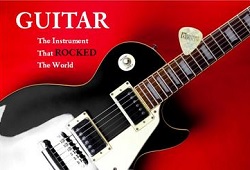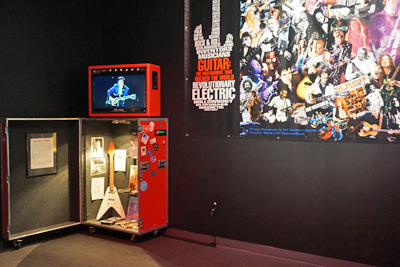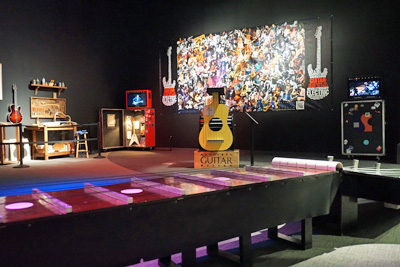
“A man playing guitar,” the musical group Chicago sang in 1972. “Will you help him change the world?” A decade earlier, many musicians tried to do just. Bob Dylan emerged in the early 1960s as “the voice of a generation,” singing about the Civil Rights Movement and threat of nuclear war. The Beatles likewise spoke for their generation when they sang “All You Need Is Love,” while the Rolling Stones conveyed the growing unrest amongst the youth of the world with “(I Can’t Get No) Satisfaction” and “Street Fighting Man.”
As Chicago noted, all of those anthems began with “a man playing guitar,” and the National Guitar Museum crafted a traveling exhibit in 2017 named – appropriately enough – Guitar: The Instrument That Rocked The World. From Massachusetts to Colorado, St. Louis to Peoria, fans across the country both learned about and paid homage to the instrument that not only rocked the world but provided a soundtrack for the latter half of the twentieth century and beyond. In May 2022, the exhibit made its way to the Carnegie Science Museum in Pittsburgh for a limited engagement, ready to rock the Steel City just as it had elsewhere.
Jimi Hendrix once referred to a concert experience as “Electric Church,” and with the world’s largest guitar stretching close to 44-feet across the darkened exhibit floor and 70 encased guitars on display, the setting for Guitar: The Instrument That Rocked The World likewise resembled a sacred space. The giant Gibson was an immediate magnet for visitors to the exhibit, who hovered over the behemoth as they plucked its strings.
In regards to the various guitars on display, arguably the most legendary was the “air guitar,” showcased inside an empty case. The exhibit explains that while the playing of other musical instruments – including horns, drums, and pianos – can likewise be mimicked, the air guitar has evolved beyond mere fantasizing. Although it first became popular in the 1970s and 80s as a way to duplicate the movements and facial expressions of such famed guitarists as Pete Townshend, Eddie Van Halen, and Chuck Berry, it is now also used for performance competitions. With backing audio tracks in a karaoke-like setting, individuals take the stage to display their imaginary talents and are judged on both technique and ability to interpret the songs played.
As for the actual, physical guitar, the instrument is a descendent of the lyre from Ancient Greece, which resembles a hand-held harp. A simple stick with strings attached to the top and bottom also became popular in ancient times, and the two eventually merged to create a lute. Beginning in the late 1300s, musicians attached additional strings to the lute and lengthened its neck to generate a wider range of sounds. No one knows exactly when this led to a new instrument that we now call a guitar – nor exactly why an hour-glass shape was selected for its design – but six-string guitars became part of the musical culture by the 1790s in both Europe and the Middle East.
The word “guitar,” meanwhile, is a hodgepodge of various names used for similar instruments dating back two thousand years – from the Greek “kithara” to the Latin “cithara,” the Arabic “qitar” to the English “gittern,” the German “gitarre” to the French “guitare,” the Italian “chitarra” to the Spanish “guitarra.”
In addition to tracking the history of the guitar and displaying examples of various designs, Guitar: The Instrument That Rocked The World also explores the science and engineering behind the iconic device. The Greek mathematician Pythagoras was one of the first to explore how notes were created on a scale, and by using a Diddly Bow – a one-string guitar with a metal slide – visitors to the exhibit were able to create not only traditional notes but microtones outside the standard scale. The various components that go into the construction of an acoustic guitar were likewise showcased, as well as explanations on how electric guitar pick-ups and amplifiers generate soundwaves.
From the opening riffs of the Rolling Stones’ “(I Can’t Get No) Satisfaction” to the soaring rendition of “The Star-Spangled Banner” by Jimi Hendrix, the collection of notes and chords emitted from guitars have become part of our shared collective consciousness. The instrument has even had an impact on Geek Culture – during the early days of science fiction conventions, attendees spent their evening hours inside hotel rooms, listening to fellow fans strum their guitars. Due to a misspelling of “folk” by a journalist in the 1950s, the resulting musical genre became known as “filk.”
In 2002, meanwhile, two brothers in Boston began writing songs inspired by the Harry Potter book series, called themselves Harry and the Potters and launched a “wizard rock” revolution that featured over 800 similar bands a mere five years later. Even Star Trek has Five Year Mission and the Roddenberries, while the television drama Lost was musically immortalized by the Oceanic Six.
“A man playing guitar,” the musical group Chicago proclaimed in 1972, “singing for us all.” As the Guitar: The Instrument That Rocked The World exhibit makes clear, those words proved to be prophetic.
Anthony Letizia





